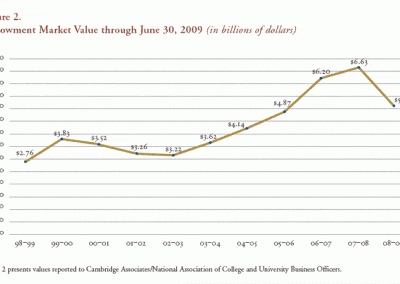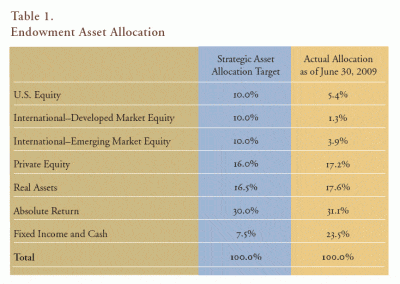The Endowment
The University of Chicago’s endowment finished fiscal year 2009 with a market value of $5.09 billion, including $415 million of Medical Center endowment. This represented a decrease of $1.54 billion from the June 30, 2008, value of $6.63 billion. Ninety-seven percent of the endowment is invested in the Total Return Investment Pool (TRIP). TRIP’s return, net of outside management fees, was -21.5 percent for the fiscal year.
The portfolio was adversely affected by the crisis in markets around the world. U.S. equities as measured by the Russell 3000 Index lost 26.3 percent, while the Morgan Stanley Capital International (MSCI) World Ex-U.S. Index was down 31.2 percent. Diversification provided some help in loss avoidance, as alternative asset classes generally outperformed stocks. Bonds and cash were the only positive returning asset classes during this past fiscal year. TRIP’s fiscal year 2009 performance performed near the median when measured against the endowment returns of peer institutions (see figure 1).
The endowment’s long-term performance is especially important given its dual role of providing support for current operations and for future generations. Between July 1, 1999, and June 30, 2009, with the help of solid investment returns, generous alumni support, and prudent spending, the endowment increased from $2.76 billion to $5.09 billion (see figure 2). During that period, Chicago earned an average annual return of 7.3 percent or 100 basis points ahead of the benchmark, while gifts to endowment totaled $588 million.
Endowment Management and Asset Allocation
The Investment Committee of the Board of Trustees is responsible for overseeing the investment of endowment funds. The committee’s all-volunteer members, most of whom have significant professional experience managing investments, are trustees and alumni of the University.
The endowment is well-diversified among a variety of asset classes, with the investment objective of earning equity-like returns with less volatility (see table 1). The strategic asset allocation is reviewed regularly and approved by the Investment Committee. A staff of investment professionals manages the allocations within specific committee-approved ranges. Deviations from the strategic asset allocation are the result of structural factors, such as the difficulty of accessing quality investment opportunities in the private equity and other sectors, and active decisions by staff and the Investment Committee.
In order to meet the return objective, the asset allocation is biased in favor of a broad range of asset classes with equity-like characteristics. To reduce volatility and diversify against adverse equity markets, the endowment also has allocations to high-grade fixed income, real estate, and other real assets.
The Role of the Endowment
The fundamental purpose of the University’s endowed funds is to support the core academic mission of the University by supplying a steady source of income to supplement the operating budget. Currently, the endowment provides approximately 11.2 percent of total revenue. One of the goals in managing the endowment is to increase its contribution to operations. To the extent that University operations can be supported from the endowment, scarce unrestricted funds can be allocated to other University priorities.
Spending from the endowment is used primarily for academic purposes, going toward academic programs, instruction and research, faculty salary support, student aid, library acquisitions, and maintenance of the buildings and classrooms.
Maintaining and growing the value of the endowment over time is critical to ensuring that the steady source of income the endowment provides will not be eroded. At the University of Chicago, that is accomplished in a number of ways, including a well-diversified portfolio and a conservative spending policy.
Endowment Spending
The control of endowment spending, a critical factor in maintaining value over time, is a responsibility that is vested in the trustees of the University. Each year as part of the budget process, the trustees are asked to approve a level of spending that is within the range of 4.5 to 5.5 percent of a twelve-quarter average market value, lagged a year. The flexibility afforded the trustees by virtue of the range allows them to lower the rate of spending during periods of market appreciation and to increase it during periods of decline. This spending rule, which was implemented with the fiscal year 2005, is fairly conservative in its intent and is designed to strike a healthy balance between long-term asset preservation and prudent spending for current operations. It has the added benefit of cushioning the payout from sudden swings or shocks in the financial markets.


